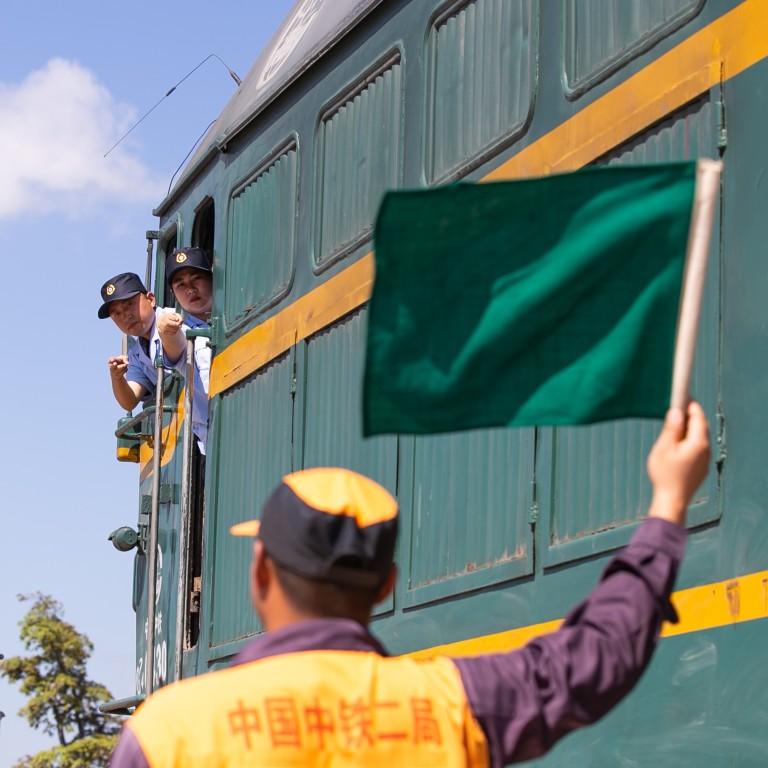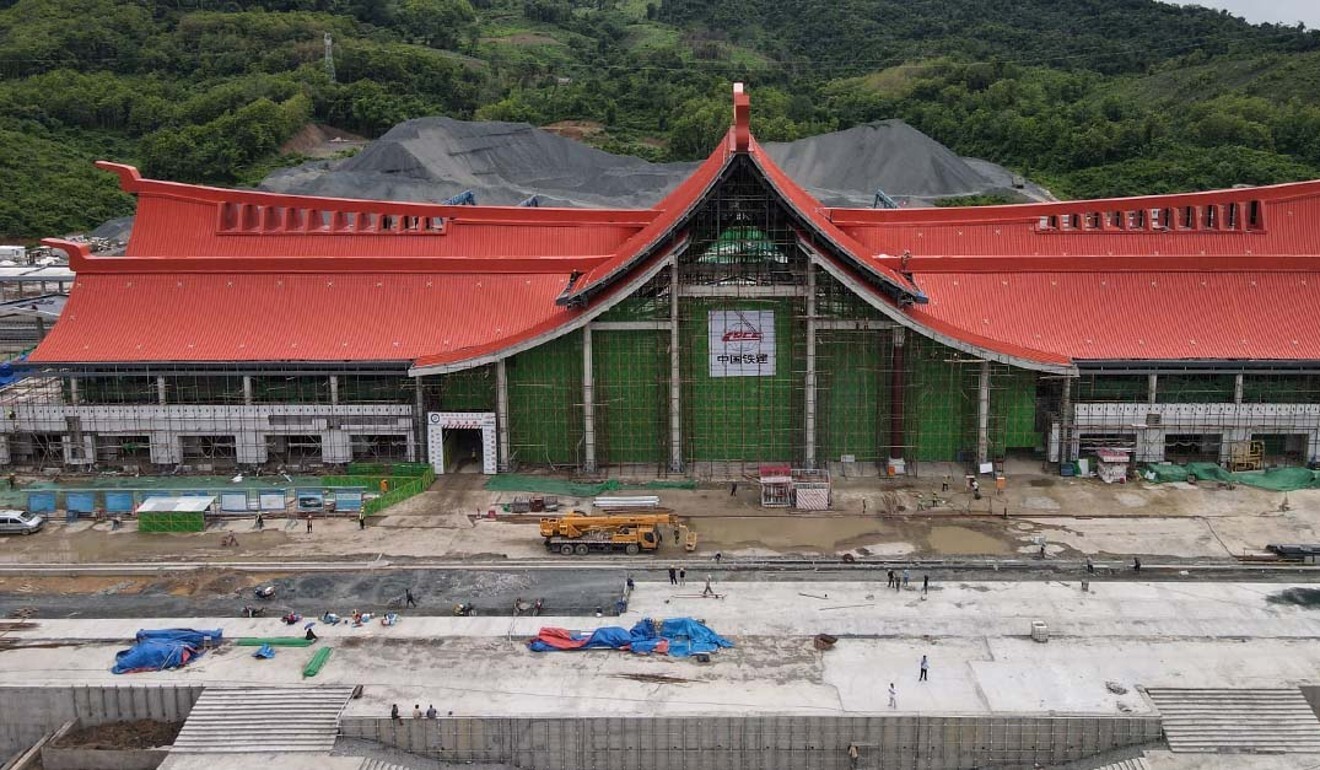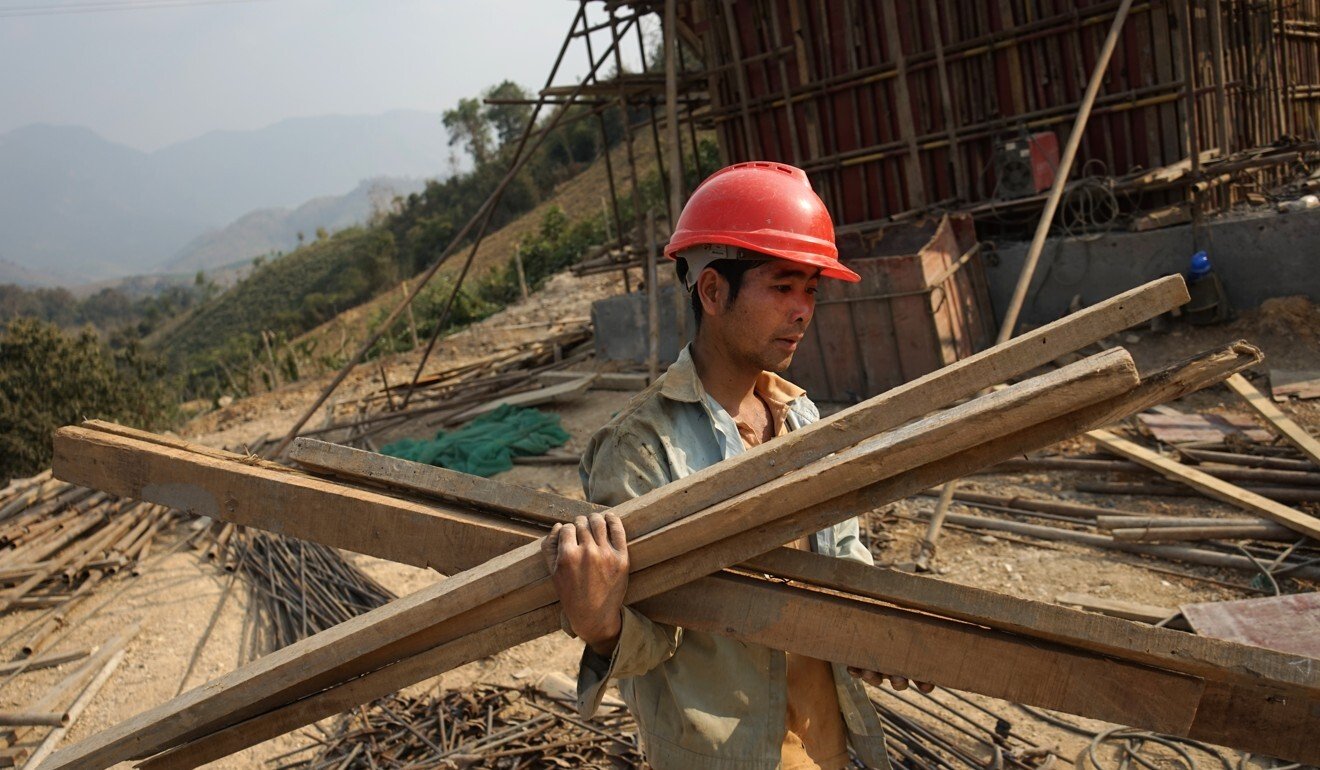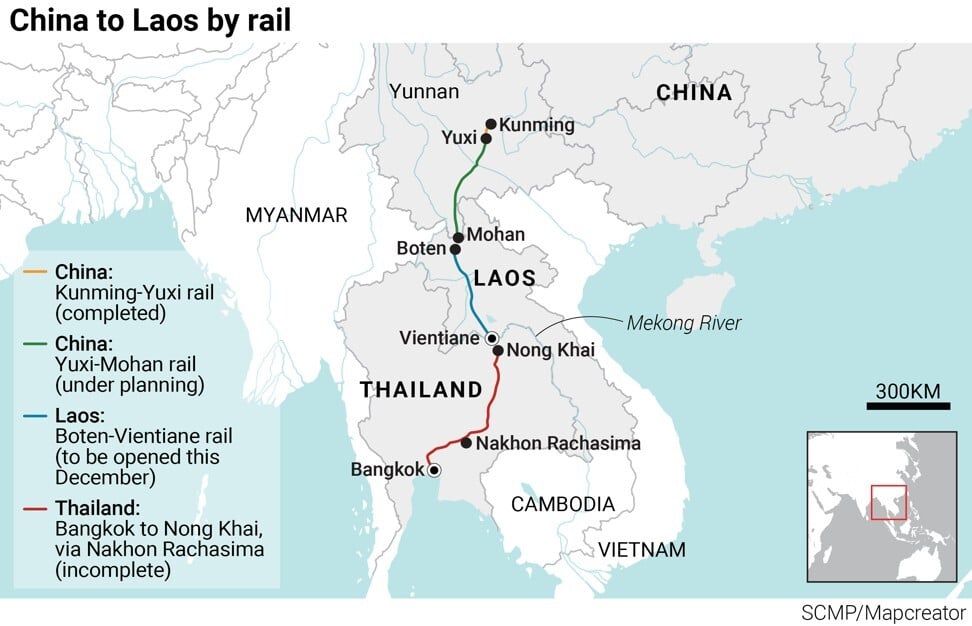
Laos’ China-funded belt and road railway: Thailand licks its lips, but fears for Luang Prabang’s World Heritage Site
- Laos section of pan-Asia rail route linking Kunming in China to Singapore expected to boost trade and tourism
- But critics say Laos could struggle to repay Chinese debt; that only a fraction of the population will benefit; and that overtourism could threaten Luang Prabang’s world heritage status
As Laos prepares to launch its section of a pan-Asia rail route that will eventually connect China to Singapore, the project has been regarded as cause for celebration for some but concern for others.
The Laos section of the route – a 414km, US$5.9 billion high-speed line financed by China – is expected to open this December and will run half the length of the country, from Boten, on Laos’ northern border with China, south to Vientiane, on its border with Thailand.
In particular, businesses in the Thai province of Nong Khai, which is just across the Mekong from Vientiane, are hoping to cash in on the increase in Chinese visitors and have proposed various schemes – from building a new theme park and infrastructure to overhauling customs procedures and creating a special trade hub – to lure them over the border.
But some critics warn that in Laos the economic boost is unlikely to be spread among the population at large and that the country could struggle to repay Chinese loans, meaning it may have to grant China concessions over the use of its land or other resources. They also warn the potential of overtourism could hurt some of the country’s best known sites, such as the World Heritage Site of Luang Prabang.
Excitement and scepticism
According to the World Bank, the opening of the Laos line could increase trade flows between China and Laos from 1.2 million tonnes in 2016 to 3.7 million tonnes by 2030.
The line will cut the journey time from Vientiane to the Chinese border to less than four hours, compared to 15 hours by car. At Boten, the line will then connect with a 595km link heading north to Kunming in China’s Yunnan province. The southern end of the line will eventually connect with a Thailand portion of the rail route, that will connect Nong Khai to the Thai capital of Bangkok via Nakhon Ratchasima.
While this greater connectivity has been a cause of much excitement among some economists, there are also worries about the costs involved and Laos’ ability to repay China.
The project is worth about a third of Laos’ GDP and the country has already racked up an estimated US$1.5 billion in debt to China, according to Vannarith Chheang, a visiting fellow at the Singapore-based ISEAS-Yusof Ishak Institute think tank.
“China has reportedly started delaying or writing off some of the debt Laos is building up to pay for the railway and other Chinese-backed projects in exchange for asset transfers,” he wrote in a paper last month.

Thailand’s section of the project will also incur a hefty bill, with the first phase of the Thai line – a 253km link between Bangkok and Nakhon Ratchasima – set to cost 179 billion baht (US$5 billion). The larger size of the Thai economy has meant concerns over the cost have until now been more muted than in Laos. However, with Thailand’s public finances having taken a huge hit from the Covid-19 pandemic, there are also questions as to how the second phase, the Nakorn Ratchasima-Nong Khai route, will be funded.
The Thai government has granted the China Railway Design Corporation and China Railway International a 50 billion baht contract to purchase tracks and train carriages; install electrical, signalling and communication systems; oversee personnel training; and to operate and maintain the rail.
Greg Raymond, a Southeast Asia expert at the Australian National University, said the Laos government was determined for the country to leave the ranks of least developed countries and saw “large-scale infrastructure as the solution”.
Laos’ position was similar to other Mekong states in the post-Cold War era that often saw increasing connectivity as a way of strengthening regime security, building prosperity and avoiding conflicts, he wrote in a recent academic paper.

Risks and opportunities
However, critics too say the financial costs are only one aspect of the project. They warn overdevelopment and overtourism are also risks, particularly in areas famed for their tranquillity and serenity, such as the World Heritage Site of Luang Prabang and Vang Vieng, both of which are home to stations on the Laos route and are expected to undergo major changes when it opens.
These two picturesque areas have long attracted travellers on a budget who come to glimpse a corner of Southeast Asia where life is untouched by the breakneck economic development of its neighbours.
Concerns are particularly high for the ancient city of Luang Prabang, the world heritage status of which is already under pressure from the construction of dams on the Mekong.
What China’s struggles with a Thai railway say about the Belt and Road
In March, Unesco advised the Laos government to conduct an impact assessment on plans for the massive Luang Prabang hydropower project, situated 25km upstream from the World Heritage Site.
Construction on the project by Thai company CH Karnchang, which built the downstream Xayaburi dam, is currently stalled as a power purchase agreement is yet to be secured.
“The value of Laos’ most precious cultural heritage site is threatened by both the dam upstream and the new high-speed rail coming from China,” said Brian Eyler, Southeast Asia Programme Director at the Stimson Centre think tank.
“The actual area of Luang Prabang’s Unesco World Heritage Site is only about eight square kilometres and is home to the town’s major tourist destinations including hotels and restaurants.
“Such a small area is not built or adaptable for a huge flood of Chinese tourists that could visit from China’s Yunnan province and [elsewhere] coming via the high-speed rail.”

Raymond of the ANU said: “It is not always clear that the Laos government is doing the work necessary to minimise the impact on local communities and to preserve the environment,” especially when “the railway is expected to further increase Chinese tourism.”
“The Laos government will need to plan carefully to preserve the cultural heritage of Luang Prabang and ensure that Laos businesses benefit from the higher inflows,” Raymond said.
However, on the other side of the Mekong many see the projected flood of tourists as a boost for Thailand’s northeast.
Varavudh Meesaiyati, president of the Thai Business Association of the Lao People’s Democratic Republic, said that while Thailand’s south had long benefited from Chinese tourists visiting Bangkok, Chiang Mai and beach resorts, Laos’ high-speed rail could bring more Chinese visitors to Thailand’s Isaan region, as the northeast is known.
“We expect many Chinese to cross to the Thai side so we have to present a new tourism mascot, maybe the naga,” said Varavudh, referring to the mythical serpent said to reside in the Mekong.
He added that costs and time spent exporting agricultural goods like mangoes or durians from Thailand to China would be reduced, though he acknowledged there would also be an influx of fruits in the opposite direction which would provide competition to local suppliers.
A World Bank report in 2020 estimated the Laos-China portion of the rail project could reduce transport costs between Kunming and Vientiane by 40-50 per cent, and between Kunming and the Port of Laem Chabang in Thailand.
Explained: How a Thai railway could fast-track China’s interests in Southeast Asia
Benefits for the few?
Sceptics warn that too often in the past only a fraction of Laos’ population has benefited from their government’s development model. Others say China will benefit more from the opening of the railway than Laos itself.
Aat Pisanwanich, director of the Centre for International Trade Studies at the University of the Thai Chamber of Commerce, said that Laos would get only “about 40 per cent of all the tourism income” because “most tourism businesses in Laos are owned by Chinese”.
Aat estimated there were around 3 million to 4 million Chinese living and working in Laos at present and that this could rise to 10 million after the opening of the railway.
Panitda Saiyarod, lecturer at Chiang Mai University’s department of sociology and anthropology, said the railway might not be in Laos’ long-term interests because the country had a tendency to repay Chinese debts by handing over the use of resources like land.
Panitda said that as more debts became due further concessions could be given to Chinese developers of special economic zones.
There are already a dozen or so special economic zones in Laos, about half of them run by Chinese companies.
Among them is the Golden Triangle Special Economic Zone, which was granted a 99-year lease in 2007 and comprises developments of apartments, hospitals and casinos.

The zone is run by Kings Romans, a Hong Kong-registered company whose founder Zhao Wei was sanctioned by the United States in 2018 for “engaging in drug trafficking, human trafficking, money laundering, bribery, and wildlife trafficking, much of which is facilitated through the Kings Romans Casino located within the Golden Triangle Special Economic Zone”.
Eyler, from the Stimson Centre, described Laos as “a zone of foreign competition” and said that while the Laos government was “committed to sustainable development in its official discourse”, it lacked “regulatory frameworks and the human capacity to reduce environmental and social impacts of infrastructure development projects”.
“I think the Laos government should place higher priority on approving projects, like eco-tourism or light manufacturing, that deliver tangible economic benefits to broad sets of beneficiaries rather than projects that reward few and create problems for many,” he said.
Varavudh said only a small proportion of the population benefited from internationally-funded projects in the transport and hydropower sectors.
“There have been a lot of changes in Vientiane in the past years,” said Varavudh, citing the expanding banking sector for having boosted the workforce in cities.
“But in the countryside, there’s no enthusiasm for [such development]. Life remains as it always has been.”
Regardless of any objections, experts say the project is too important to fail.
Panitda said that despite Covid-19, China and Laos would make sure the opening of the Boten-Vientiane rail line went ahead as scheduled.
“It will be proof of the belt and road’s first success in Southeast Asia. It will be regarded by both governments as a major achievement and it will showcase China’s political, economic and technological influence. It will show the world how China is a good friend and neighbour to Laos,” she said.


